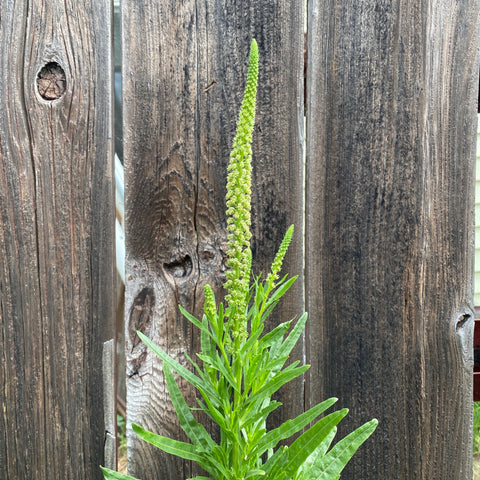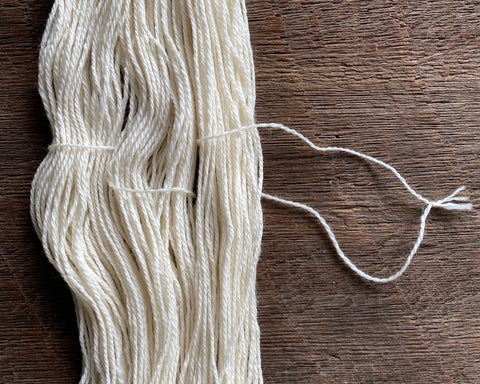News / mordanting
May - Dye-It-Yourself: Mordanting

It’s May! Some of our dye gardens are growing, others are still getting ready. Are you taking photos of your garden process? If so, we’d love to see them. You can always post them on social media, tagging @sinceresheep and using the hashtag #sinceresheepdiy, or if you’re not on social media, you can email us. We are so excited to share in your garden joy!
As we continue our year-long Dye-It-Yourself series, there might be no better topic for May than mordanting. Mordanting an important step in the natural dye process, and it’s something you can do while you wait for your garden to grow. And if you'd like to skip this step completely I have listed some mordanted Cormo yarn so you can get straight to the dyeing!
But what is mordant, and why is it important to the natural dye process? Mordant is a substance that is used to set or bind dyes to plant fibers (like cotton or linen) or protein fibers (like silk or wool) by forming a chemical bridge between the dye and the fiber. Without a mordant, natural dyes won’t stick as effectively to plant or protein fibers. Mordants are often made from minerals, although tannins can also be used in the mordanting process with cellulose. Your choice of mordant--whether it be Alum, Copper, Iron, or Tannins--will affect the ultimate color of the dye you use. For this project, we recommend using Alum (Potassium Aluminum Sulfate) as a mordant for your protein fiber yarns.
There’s no need to wait to mordant your yarn, either! Planning ahead and getting your mordanting done before you’re ready to dye can be smart. If you do this work ahead of time, you won’t be trying to fit it in when your plants are ready for harvest and dyeing.
Whenever you start the mordanting process, you probably want to start your Dyer’s Notebook. In your notebook, you can write down what yarn you are using, what mordant you’re using, and any other things you want to remember during the dyeing process.
Here’s the mordanting process we recommend for protein yarn:

- Step 1 – ‘Dye-tie’ your yarn. – Using un-dyed waste yarn, loosely tie your skein of yarn in 2 places using a figure eight. Also check to see how the ends of the skein were tied and re-tie loosely if necessary. You want to leave lots of room so the ties don’t restrict the dye.
- Step 2 – Weigh your yarn. – Before you get your yarn wet, weigh your skeins in grams. If you don’t have a scale but the yarn was labeled with a weight, use that figure. Be sure to write this number down.
- Step 3 – Scour your yarn. – Either fill your sink or your top-loading washing machine with hot water. Once you have the right amount of water, add a few drops of dish soap and submerge your yarn in the water. Leave the yarn for at least a half an hour before you either spin it out or gently squeeze it out. If there is too much residual soap in the yarn, repeat this process omitting the soap on the second round. Be gentle; you want to avoid agitating the yarn.
- Step 4 – Mordant your yarn. – Multiply the total weight of your yarn by 15% to figure out the amount of Alum you need for mordanting. Weigh or measure the amount of Alum into a measuring cup. Dissolve the Alum in boiling water. Fill your dye-dedicated stainless steel or enamel pot with enough cold water to cover your yarn and add your dissolved mordant. Place the yarn in the pot and slowly heat, bringing to right below a simmer. Ideally your yarn should be at this temperature for about an hour. Turn off the heat and let your yarn sit for a minimum of an hour, or overnight.
- Step 5 – Rinse your yarn. – Wearing gloves, remove your yarn from the mordant and gently squeeze out excess liquid. Fill up your sink or top-loading washing machine with cold water and put your mordanted yarn in for a very brief soak to rinse off any excess mordant. Spin out or gently squeeze out your yarn. Your yarn is now ready to dye!
Resources for where to buy alum:
Books and websites with info about mordanting:
- The Art & Science of Natural Dyes by Joy Boutrup & Catherine Ellis
- The Modern Natural Dyer by Kristine Vejar
- Maiwa's guide to natural dyes
Third Wave of Planting
This month is also our third and final wave of planting! If you haven’t yet planted your garden, now is the time.
